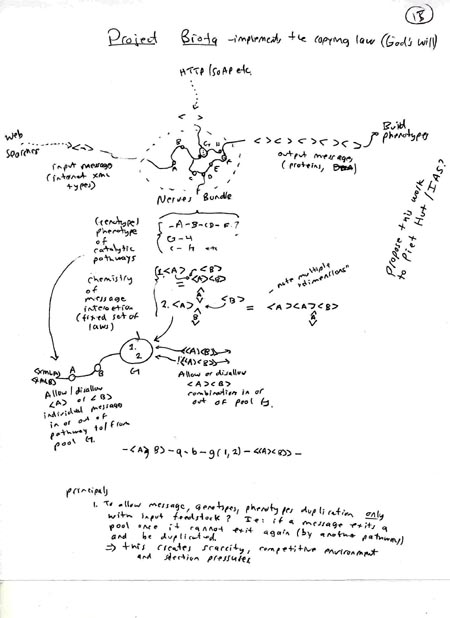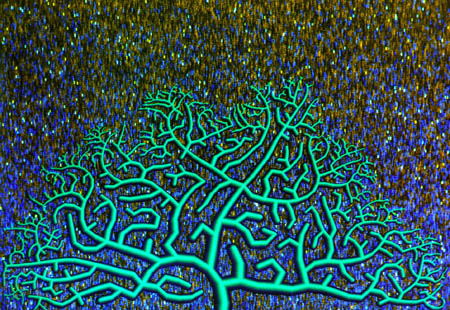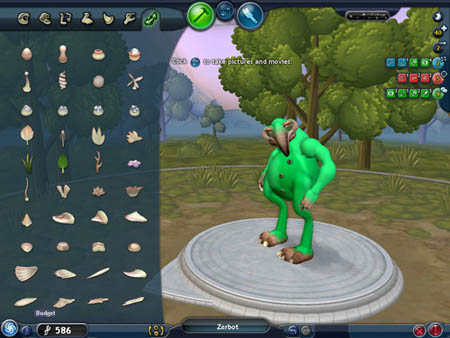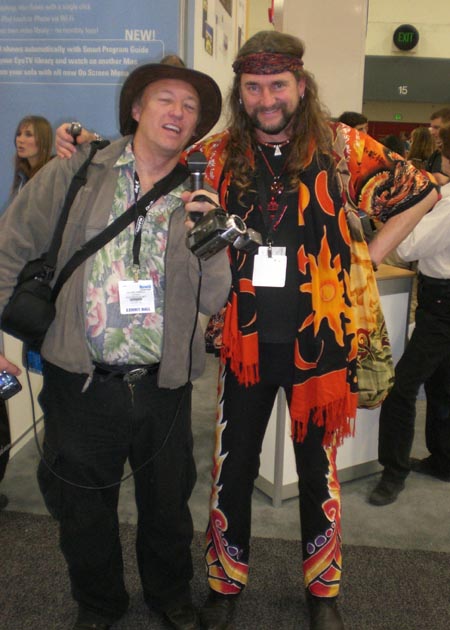Imagine an L-System forest, a herbivore simulation and a carnivore simulation all developed separately without each having its own graphical front end. Each object in the separate simulations would communicate locally or via the network using some agreed upon protocol. Next, picture one or more 3D front end “view portals” with all the bells & whistles that visualize what is going on in the engines and traffic, putting any local “area” together into a coherent scene.
If it existed, such an A-life system could be run as a true grid, an “Evolution Grid” or “EvoGrid” if you will, with the computation not limited to one processor or one 3D scenegraph’s rendering step clock. Developers could focus on their areas of strength while the quality of the collective simulation grid would improve much faster than any one individual effort. And perhaps best of all, new developers could connect their engines, protocols or view portals into the grid or take up development of existing engines and protocols so that no projects need stagnate or die. So with this vision in hand, is something like the EvoGrid possible, workable, desirable, and doable? (Bruce Damer, 2008)
When Bruce Damer told me he is working on evolution technologies (ETs) that will come “alive” towards the end of the 21st/beginning of the 22nd Century, I pricked up my ears!
A world renowned guru of our digital past and future (see of Bruce’s projects at his personal page Damer.com and his Digibarn Computer Museum), Bruce is in the advance guard of many emerging fields, including: social visual computing – avatars and virtual worlds (see his book Avatars, 1997 and compendium of Avatars events); NASA research – surface robotics, spacecraft and mission design, agent-based modeling, and real-time physics (see DigitalSpace for space projects from 2000-2008); and, artificial life – cellular automata, complex and emergent systems (see Biota.org and the Biota Podcast with Tom Barbalet).
Bruce Damer’s architectural notes for the EvoGrid router, a finite state machine that will consume XML
EvoGrid – an evolution technology grid
Bruce envisages a grid (EvoGrid.org) in which current work on artificial life research being done with teams at NASA, universities, and in the artificial life developer community, e.g., the work of Ventrella (see below), can interact in a common ecosystem.
Bruce plans to build EvoGrid on an open source framework, communication grid and protocol (Zhengyou & Yichuan 2004) allowing future developers to extend the EvoGrid and add their own objects or virtual creatures.
By running the simulations without visuals, the evolutionary algorithms of EvoGrid will be able to develop huge populations that can interact with other large populations evolving in real time. But, with their emergence into the social visual 3D space of a virtual world, they will hit the wall of physics.
The public 3D immersive portal into the EvoGrid will support the simulated evolution of biologically inspired forms. The portal will be a virtual space where they will interact with human users.
This window into the human world raises many interesting questions. Will the algorithms/artificial life forms themselves decide when to emerge into the public eye? Or, will they be pushed out by other life forms, or summoned forth by human voyeurs/god(s)?
But, regardless of how artificial life algorithms eventually emerge into cyberspace, this will be an important step in exploring the far reaching implications of the possible emergence of artificial life from algorithms into atom space.
From Algorithms to Atom Space
J. Doyne Farmer defined a living thing as a pattern in spacetime, able to reproduce itself using a stored information blueprint, employing an internal metabolism driving interdependent parts to interact with and deal with a chaotic environment. Above all, he put forth that a lineage of living things also possesses the ability to evolve through time (Farmer & Belin, “Artificial Life: The Coming Evolution,” 1991).
Our world and ourselves are products of this collective natural technology (whether one believes it is guided by an unseen God or not). Others have argued further that human culture, whether it is in the form of writings, music, ideas and the arts also employs some of the same underlying methods to spread and evolve (Richard Dawkins, The Blind Watchmaker, 1986). Therefore, beyond the physical laws of nature, the most powerful force shaping the universe is what we might call “evolution technology.†(Damer 2008)
The picture above is from Jeffrey Ventrella’s website.” JJ Ventrella is a programmer-artist doing virtual world design and artificial life research. He was Principle Inventor and second co-founder of There.com, and most recently, Senior Developer at Linden Lab. “Ventrella writes papers and chapters on topics centered around evolutionary computation and creativity.”
Ventrella is also the creator with Brian Dodd of Darwin Pond.
Darwin Pond is an imaginary gene pool, a primordial puddle of genetic surprises. More technically, Darwin Pond is an Artificial Life Simulation: a virtual world exhibiting the emergence of life-like behaviors. But it’s more than just a fun and informative thing to watch, you can participate in this artificial life simulation by building scenarios and setting up experiments.
What are the possibilities for artificial life?
Evolution technology is the use of the principles of evolution as seen in nature to rapidly develop new software, chemicals, genes or materials, devices or full robotic machine systems.
Bruce is developing EvoGrid to ask some big questions about our future: Can simulation be used to deduce how life came about? Can simulated biological environments be used to create powerful and transformative technologies? Can artificial life evolve into semi-living machines that can clean our atmosphere and heal our bodies?
“Evolution is a powerful tool,” Bruce notes. It can be used in constructive or destructive ways. “We should use it to make tools – the mechanisms by which we will survive and thrive.”
When our bodies are married to this kind of technology we may live for hundreds of years.
Bruce sees the next generation of space exploration emerging out of these artificial life forms born in cyberspace.
They should be able to work in actual hardware – intelligent manufacturing done at the lowest molecular level.
If we are truly going to travel and live beyond the earth’s biosphere we have to go beyond the 19th century technology that space exploration has depended on up to now. Our spacecraft would be recognizable to the great steamship engineer Isambard Kingdom Brunel, made of pressure vessels and other hard parts. These craft are fragile and subject to “single points of failure” (i.e, one seal goes and there goes the mission).
In order for longer term survivable spaceflight, especially for human crews, these craft will have to almost be alive, or at least be made up of billions of individual micro or nano-parts that are self monitoring and self healing. In this scenario, human crews are going to be like the brain organs in a larger biologically inspired vessel. I believe we are decades, maybe even centuries, from this kind of technology, but it will come.
In addition, evolved biologically-inspired robotic systems will mine outer space resources and prepare the solar system for Earth-life.
Picture trillions of flakes of solar collecting chemical nano-factories working something like an “ET lichen” coating the surface of a richly endowed asteroid, processing its stores of water ice, organic compounds, or metals. Human crews would stop by such asteroids to allow themselves (and their ships) to “feed” on the ET lichen. Indeed if the ET lichen manage to hollow out the asteroid and generate the correct mix of gases then the human crew could step inside for a break.
Other versions of “ET lichen” would have the potent capability of terraforming our own planet enabling us to cope with climate change and other effects of our civilization. As many science fiction writers and Hollywood directors has shown us, out of control ET lichen may also lead us to total annihilation.
The Artificial Life Programmer, the New Alchemist?
Like the medieval alchemists before them, programmers developing “Artificial Life” software (often shortened to “A-life”) are drawn to the elusive yet seductive proposition that they have the power to animate inanimate matter (Steen Rasumussen), except that in this modern incarnation of alchemy; the inanimate medium is a microscopic substrate of billions of transistors. (from “God, Science, and Intelligent Design,” chapter by Bruce Damer, upcoming in World Scientific, Singapore)
Bruce points out there is frequently confusion between the two fields of Artificial Life and Artificial Intelligence. But this confusion, he notes, is a fertile field of inquiry.
A-life is a “bottom up” approach, wherein developers simulate “a large number of simple interacting components employing relatively simple rules from which complex behaviors of whole systems emerge (Chris Langton et al). AI on the other hand has tackled the ever receding goal of creating a “conscious” entity with which we would one day be able to communicate.”
God in the A-Life Universe
In his article for an upcoming book, “God, Science, and Intelligent Design,” Bruce undertakes a thought experiment in which he draws insights from the field of A-Life into a broader Intelligent Design/Creationism vs Evolution discussion.
The open question, “what is life?” underwrites the field of A-Life much as the question “what is consciousness?” does the field of Artificial Intelligence. And, these questions beg others on the role (or absence of role) of God(s).
Will Wright’s Spore: “God as the Intelligent Designer”
The screenshot above (see CNET for more) is from Spore the much anticipated new game from “Sims” creator Will Wright. Electronic Arts just announced that Spore, released through its Maxis Software brand, will go on sale on the weekend of Sept. 7, 2008. It is billed as “massively single-player” game, that “lets users create a universe, evolving from tiny organisms into civilizations capable of intergalactic travel.” (Canadian Press)
Bruce compares Spore with Karl Sim’s Evolved Virtual Creatures and argues they demonstrate two kinds of God in the A-Life universe:
Karl Sims’ – God the Mechanic setting up the initial conditions and then returning only occasionally to view the current state of the simulation; and the Will Wright, Intelligent Designer God, constantly providing opportunities to use and outside intelligence to steer the direction of the virtual universe.
The properties of A- Life software in its early phases can be represented along a continuum which at one end can be represented by Karl Sim’s evolving virtual creatures (see below) and on the other end Will Wright’s game Spore.
Karl Sim’s “Evolved Virtual Creatures” – “God the Mechanic”
Karl Sim’s creatures start life as a simple pair of hinged blocks in a virtual universe that simulates basic physical properties such as gravity, collisions and surface friction. From that point on the simulation was allowed to continue on its own without human intervention (although random mutations were introduced automatically into the “genome” of creatures between generations).
Bruce Damer’s: “God As the Intelligent Adapter”
Bruce analyzes “the copying rule,” as a fundamental principle of life in his article for the forthcoming book “God, Science, and Intelligent Design:”
A living organism differs from bare rock, gasses or a pool of liquid in ine very specific way: the living organism contains instructions that are copied, for the most part unaltered, from one version to the next.
Bruce argues, quite brilliantly, that the Copying Rule, along with the “Laws of Nature†and the element of uncertainty leads us to a notion of God not as an influencer of the future but as an “adept adapter†. And if you don’t see God in the picture the understanding of evolution by cumulative adaptation is even more remarkable for the fact no hand guides it.
Those who wish to celebrate the presence of a God in their lives and in all nature can believe that, God as the Brilliant Adapter, played a hand in the survival and glorious diversification of life on Earth as well as the blossoming richness of human culture and technology. Those who see no need to place an actor like God in the picture can celebrate and seek to better understand the process of evolution by cumulative adaptation, made even more astonishing by the very fact that no hand guided it.
“God who created all things in the beginning is himself created by all things in the end” Wrote Olaf Stapledon in 1937.
Performing the Future
The questions evolutionary technologies raise for human and planetary future are vast and far reaching. To explore the huge social and philosophical questions (Damer 2008) raised by the outputs of more advanced EvoGrids, as well as an enumeration of how evolution technologies will impact life on Earth and in space in the future, Bruce is planning a performance piece that will tour the world – “After the Evogrid.”
As a kind of cyber-hippie empresario (see Bruce above on right and his friend and Digibarn collaborator Al Lundell on the left) of nine virtual world conferences including one just three weeks ago featuring Virtual Worlds and Space for NASA, Bruce has always been deeply involved in firing the public’s imagination about the future. Now he intends to take his involvement with the public space to new heights with, “After the Evogrid,” – a “multimedia performance piece with a spoken word narrative, sound and music, and animated visuals.”
“After the Evogrid” will present both the promise and the perils of Humanity living in a symbiotic existence with the products of the new field of “evolution technology.â€
The performance piece will bring together a unique combination of evolution technologies, personal and societal impacts, full biosphere implications and the expansion of life beyond the Earth. The EvoGrid itself will create the first open extensible grid protocol for evolution simulations.
So stand by for launch into an even weirder future, brought to you by “Doc Damer”?!







0 Comments For This Post
1 Trackbacks For This Post
February 14th, 2008 at 7:40 pm
[...] Original post by UgoTrade [...]